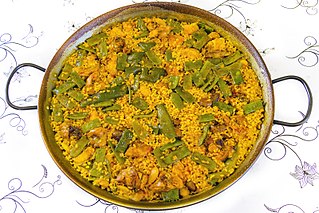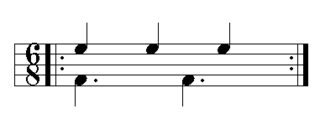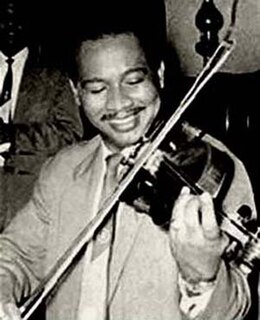A paila criolla is a Cuban membranophone. It consists of a shallow metal casing or paila (cookware of Catalan origin; in Catalan language it is called paella), with a single-headed drum.
A membranophone is any musical instrument which produces sound primarily by way of a vibrating stretched membrane. It is one of the four main divisions of instruments in the original Hornbostel-Sachs scheme of musical instrument classification.

Catalan is a Western Romance language derived from Vulgar Latin and named after the medieval Principality of Catalonia, in northeastern modern Spain. It is the only official language of Andorra, and a co-official language of the Spanish autonomous communities of Catalonia, the Balearic Islands and Valencia. It also has semi-official status in the Italian commune of Alghero. It is also spoken in the eastern strip of Aragon, in some villages of Region of Murcia called Carche and in the Pyrénées-Orientales department of France. These territories are often called Països Catalans or "Catalan Countries".

Paella is a Valencian rice dish that has ancient roots but its modern form originated in the mid-19th century in the area around Albufera lagoon on the east coast of Spain adjacent to the city of Valencia. Many non-Spaniards view paella as Spain's national dish, but most Spaniards consider it to be a regional Valencian dish. Valencians, in turn, regard paella as one of their identifying symbols.
Paila criolla was initially used by street bands in the 19th century. They are shallower in shape than single-headed tom-toms, and come in double sets, tuned an octave apart. The player (known as a timbalero ) uses a variety of stick strokes, rim shots, and rolls on the skins to produce a wide range of percussive expression during solos and at transitional sections of music, and usually plays the shells of the drum or auxiliary percussion such as a cowbell (cencerro). Pailas are always hit with straight batons [1] that have no additional head. Hits are made on the top and on the metal sides.

A tom-tom drum is a cylindrical drum with no snares, named from the Anglo-Indian and Sinhala language. It was added to the drum kit in the early part of the 20th century. Most toms range in size between 6 and 20 inches in diameter, though floor toms can go as large as 24 inches (61 cm). It is not to be confused with a tam-tam, a Gong. The Tom-tom is popular and used by players worldwide.

The cowbell is an idiophone hand percussion instrument used in various styles of music including salsa and infrequently in popular music. It is named after the similar bell historically used by herdsmen to keep track of the whereabouts of cows.
The shells are referred to as cáscara (the Spanish word for shell) which is also the name of a rhythmic pattern common in Cuban music that is played on the shells of the pailas to keep time. The shells are made of metal. The heads are light and tuned fairly high for their size. [2] Pailas are now often called timbales , but the term timbales is ambiguous, because it was also used to describe kettle drums.

Spanish or Castilian is a Romance language that originated in the Castile region of Spain and today has hundreds of millions of native speakers in the Americas and Spain. It is a global language and the world's second-most spoken native language, after Mandarin Chinese.

A drumhead or drum skin is a membrane stretched over one or both of the open ends of a drum. The drumhead is struck with sticks, mallets, or hands, so that it vibrates and the sound resonates through the drum.

Timbales or pailas are shallow single-headed drums with metal casing. They are shallower than single-headed tom-toms, and usually tuned much higher, especially for their size. The player uses a variety of stick strokes, rim shots, and rolls to produce a wide range of percussive expression during solos and at transitional sections of music, and usually plays the shells of the drum or auxiliary percussion such as a cowbell or cymbal to keep time in other parts of the song.





